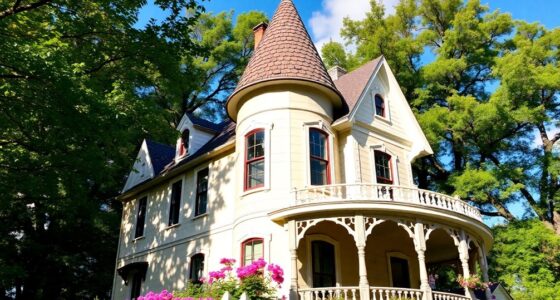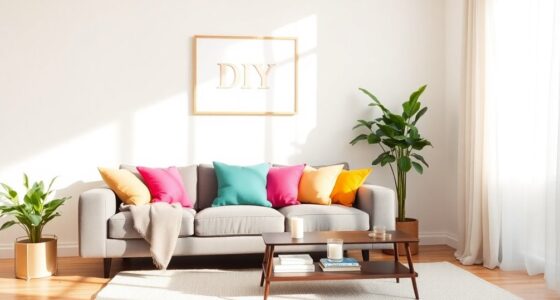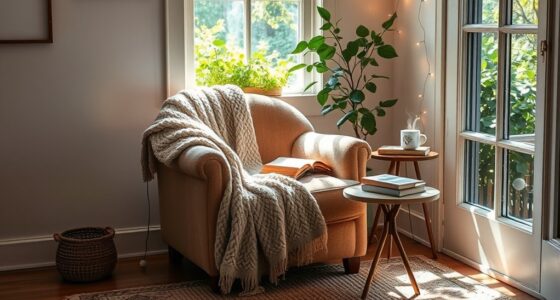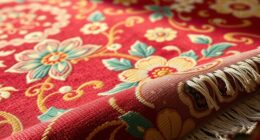A house becomes a château when it showcases elegance, history, and specific architectural traits. Typically, you'll see thick stone walls, large windows, and symmetrical layouts that reflect classic styles like Renaissance and Baroque. The surroundings often include formal gardens that echo the grandeur of these majestic structures. Inside, you can expect luxurious fabrics, intricate woodwork, and stunning décor that enhance the opulent atmosphere. Châteaux also emerge from a rich tradition of nobility, evolving from fortified structures to lavish residences. Want to explore more about the features and notable examples that define a château? You're in for a treat!
Key Takeaways
- A château is characterized by thick stone walls and large windows, reflecting its noble heritage and grandeur.
- It features symmetrical layouts and decorative rooflines influenced by Renaissance and Baroque architectural styles.
- Extensive grounds and formal gardens enhance the majestic presence of a château, distinguishing it from simpler estates.
- Luxurious interiors showcase intricate woodwork, sumptuous fabrics, and antique furnishings that convey opulence and history.
- Modern châteaux blend contemporary design with classic elements, emphasizing sustainability while maintaining aesthetic appeal.
Definition of a Château
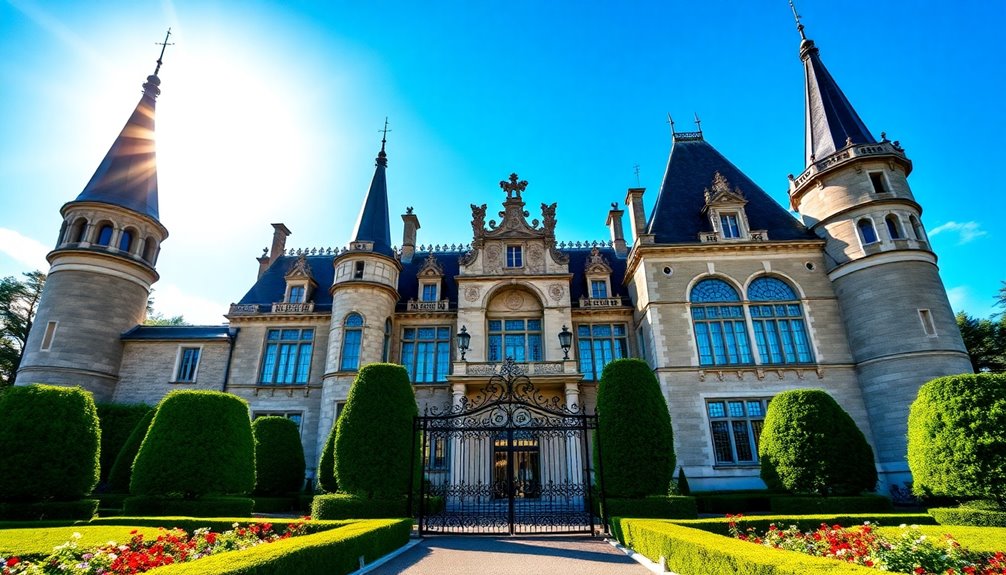
A château is more than just a large house; it's a symbol of nobility and grandeur. Originating from the Latin word "castellum," a château often showcases elaborate architectural elements, reflecting the elegance of French nobility.
These grand residences typically feature thick stone walls, large windows, and symmetrical layouts, with decorative rooflines that highlight various historical influences like Renaissance and Baroque styles.
As you explore these magnificent structures, you'll notice their extensive grounds and formal gardens, enhancing their majestic presence. Remarkable examples, such as Château de Chambord and Château de Chenonceaux, illustrate how these architectural masterpieces embody wealth and power.
Understanding the definition of a château helps you appreciate its significance in history and culture.
Historical Evolution
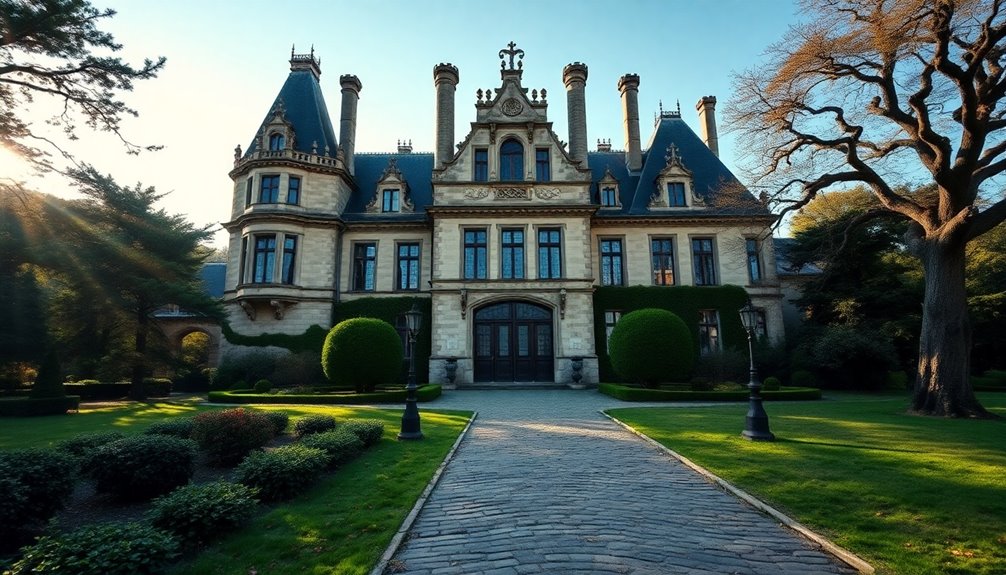
Châteaux have undergone significant transformations since their inception, reflecting changes in society and architecture. The term "château" originated in the 13th and 14th centuries, denoting fortified structures essential for defense during the feudal era.
As the feudal system faded in the 15th century, these buildings evolved into luxurious residences for the nobility, showcasing the historical evolution of societal values. The Renaissance period introduced Italian influences, enhancing architectural details and grandeur, moving beyond mere defensive purposes.
Iconic examples like Château de Chambord and Château de Blois emerged in the 16th century, blending medieval and Renaissance styles. By the 17th century, the need for fortifications diminished, giving rise to refined country villas that prioritized aesthetics and comfort over defense.
Architectural Features
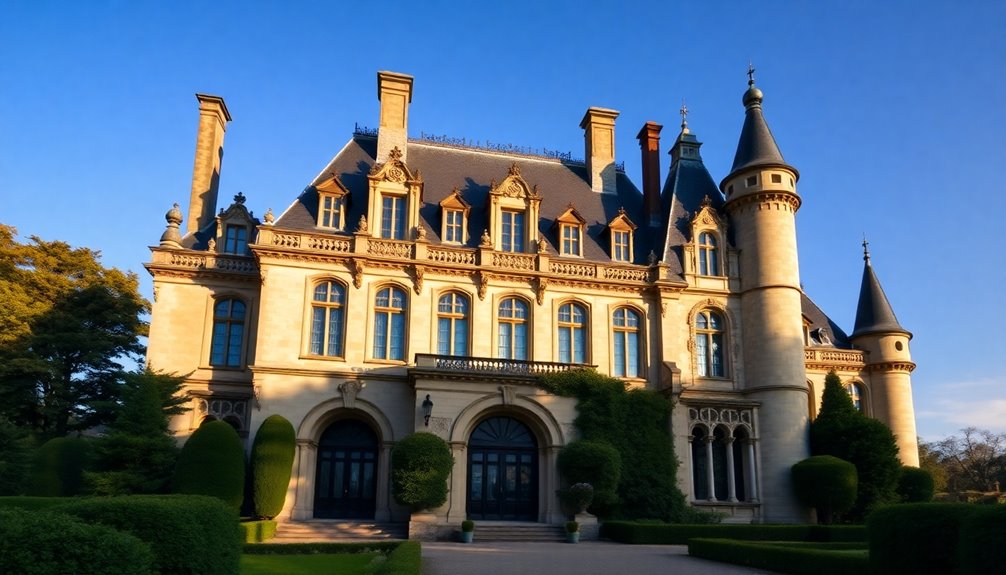
When you explore the architectural features of a château, you'll notice its defensive design elements like thick stone walls and towers that once served protection.
The layout often includes a central courtyard, enhancing both functionality and aesthetic appeal.
Inside, luxurious finishes, from intricate moldings to lavish decorations, reflect the craftsmanship and elegance of the era.
Defensive Design Elements
While exploring the architectural features of châteaux, you'll notice that their defensive design elements are integral to their identity. Thick stone walls, sometimes reaching 20 feet, were constructed to withstand attacks and guarantee safety for the inhabitants.
Many châteaux also boast towers and turrets that not only enhance the medieval aesthetic but serve as lookout points and strongholds. Moats encircle these grand structures, providing a formidable defense while adding visual allure.
Narrow arrow slits allow archers to fend off invaders without exposing themselves, showcasing clever design. Additionally, drawbridges offer controlled access, enhancing security against potential attackers.
Together, these elements create an imposing fortress that embodies both beauty and strength, essential to the château's charm.
Courtyard Layouts
After establishing their formidable defenses, many châteaux turn their focus inward to create inviting and organized courtyard layouts.
These designs not only enhance grand architecture but also foster a sense of community and tranquility.
Imagine this:
- A central courtyard that serves as a tranquil oasis, surrounded by elegant buildings.
- Lush gardens and serene water features, like fountains or moats, that add beauty and calmness.
- Arcades or loggias lining the courtyard, offering protected walkways that connect various rooms.
These courtyard layouts maximize natural light and views, with large windows and doors that seamlessly blend indoor and outdoor spaces.
This harmonious relationship truly defines the essence of a château, creating an inviting atmosphere for both residents and guests.
Luxurious Interior Finishes
Luxurious interior finishes in a château elevate the living experience, making each space feel both opulent and inviting.
You'll find ornate ceilings adorned with intricate plasterwork or wooden beams, adding a touch of grandeur to the atmosphere.
Polished marble and intricately laid stone flooring further enhance the elegance, while decorative moldings like crown moldings and wainscoting emphasize architectural details.
Large, ornate fireplaces made from stone or marble often serve as stunning focal points, complete with decorative mantels and intricate carvings.
To top it off, luxurious fabrics and textiles, such as silk, velvet, and brocade, adorn draperies, upholstery, and wall coverings, creating a sumptuous ambiance that truly defines château living.
Interior Design Elements
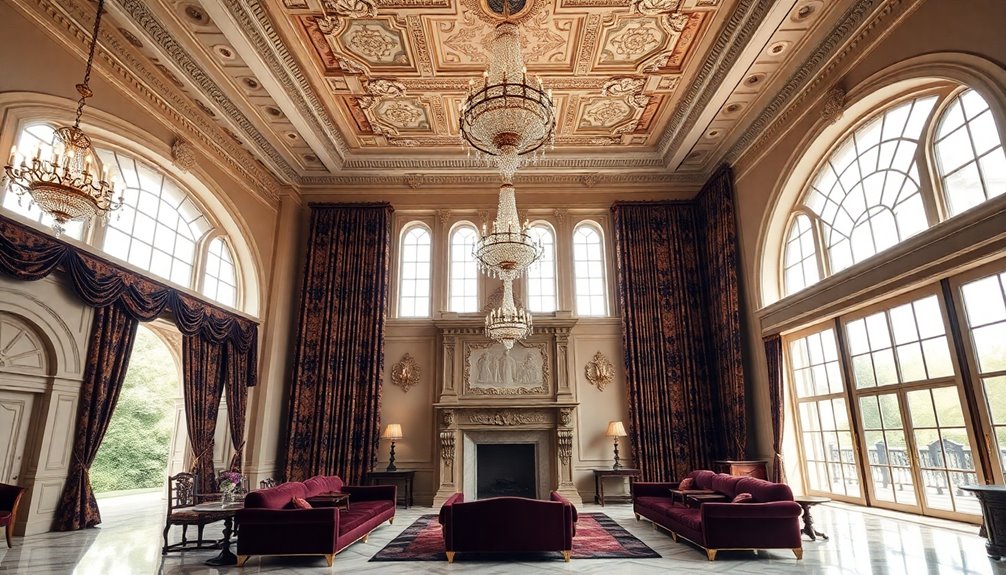
The interior design elements of a château are all about elegance and sophistication. In the French château style, you'll find a harmonious blend of luxurious fabrics and intricate woodwork that creates an inviting atmosphere.
Here are three key features that define this opulent style:
- Ornate furnishings like chaise lounges, showcasing exquisite carvings.
- Soft color palettes of muted tones, including beige and pastels, enhancing serenity.
- Antique pieces that add character and depth, promoting a sense of history.
To truly capture this aesthetic, incorporate sumptuous materials such as silk and velvet, along with ambient lighting from ornate chandeliers.
This combination not only evokes warmth but also reflects the grandeur of château living, making every space feel like a work of art.
Landscaping and Gardens
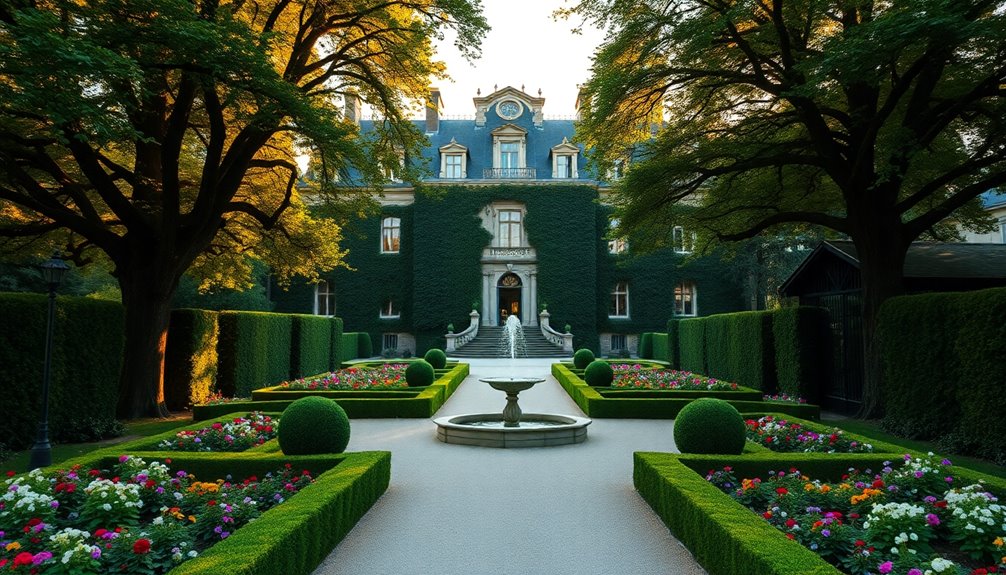
A château's beauty extends beyond its elegant interiors to its breathtaking landscaping and gardens.
You'll often find meticulously designed formal gardens that reflect the estate's grandeur, showcasing symmetrical layouts and geometric shapes. Carefully manicured hedges enhance the overall aesthetic, while water features like fountains and ponds create a serene atmosphere.
The landscaping incorporates a variety of plant species, including flowering perennials and ornamental trees, ensuring vibrant seasonal displays. Expansive parklands often blend natural and landscaped elements, inviting you to enjoy leisurely activities like walking or picnicking.
Historical gardening techniques, such as parterres and topiary, add a unique artistry to château gardens, highlighting the rich horticultural knowledge of the period. These elements together create a stunning outdoor experience.
Cultural Significance
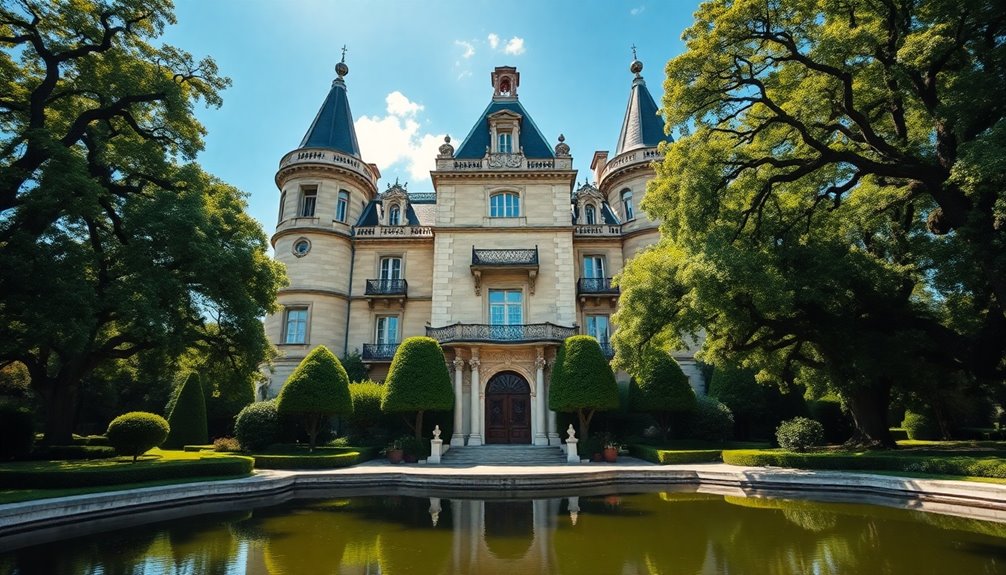
While many see châteaux as stunning architectural feats, their cultural significance runs much deeper. These grand structures are more than just homes; they embody the evolution of French society and artistry. Consider:
- Defensive to Decorative: Originally built for protection, their transformation into luxurious residences reflects a shift towards cultural appreciation.
- Regional Identity: Each château showcases unique architectural styles and materials, revealing the rich heritage of its locale.
- Artistic Patronage: The opulence and intricate designs symbolize the wealth of the nobility, influencing French culture during the Renaissance and Baroque periods. Their enduring legacy also highlights the importance of financial transparency in understanding the wealth of those who built and maintained them.
Today, châteaux stand as essential cultural landmarks, drawing visitors and preserving the historical legacy of French nobility. They remind us of their significant role in shaping societal values.
Notable Examples
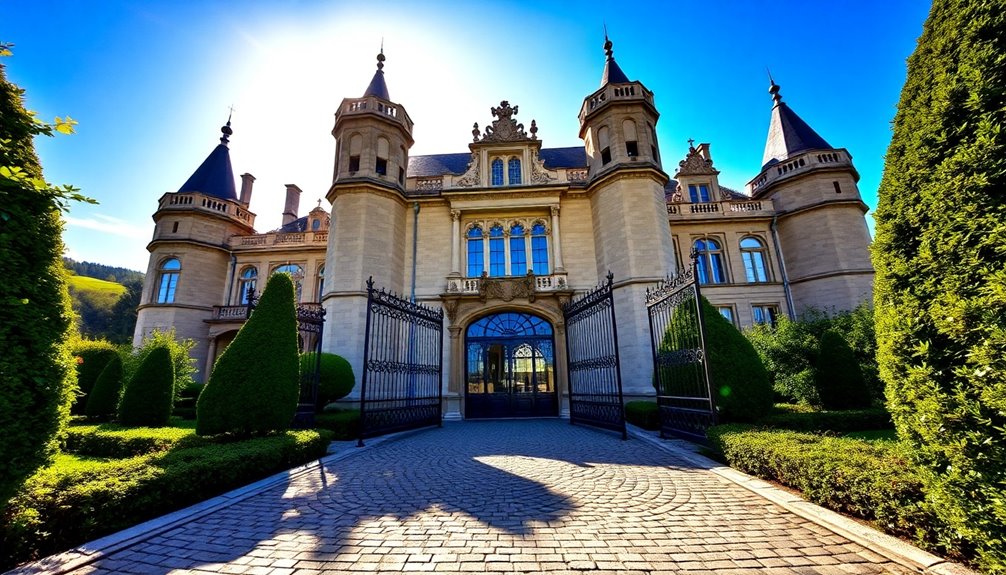
When you think of notable châteaux, several remarkable examples come to mind that showcase architectural grandeur and historical significance.
Each château, like Chambord and Chenonceaux, reflects unique design elements and rich stories from the past.
Let's explore these stunning landmarks and what makes them stand out.
Architectural Grandeur and Design
Châteaux captivate with their architectural grandeur and design, reflecting a rich tapestry of history and artistry.
You'll notice their impressive features, which often include:
- Thick stone walls and towers that combine defense with decorative elegance, harking back to medieval origins.
- Symmetrical layouts that highlight grand entrances and large windows, showcasing intricate moldings for a refined aesthetic.
- Decorative rooflines, including mansard roofs and dormer windows, adding to the imposing scale and sophistication of the structures.
Notable examples like Château de Chambord blend Gothic and Renaissance architectural styles, while Château d'Amboise incorporates formal gardens that enhance their overall beauty.
These elements come together to create an unforgettable visual legacy that defines the essence of a château.
Historical Significance and Context
The architectural splendor of châteaux tells a story that goes beyond mere aesthetics; it reflects their historical significance and the evolving role they played in society.
Originating in the 13th and 14th centuries as defensive structures during the Medieval period, French châteaux evolved into luxurious residences for the nobility as the feudal system declined. Notable examples like Château de Chambord and Château d'Amboise showcase this transformation, with the former highlighting Renaissance architecture and the latter serving as a royal residence.
Château de Chenonceaux, spanning the River Cher, illustrates the harmony between architecture and nature, while Château d'Azay-le-Rideau embodies the elegance of Renaissance style.
Noteworthy Château Examples
Exploring the remarkable world of châteaux reveals a variety of architectural wonders, each with its unique story and significance.
Here are three remarkable examples that embody the elegance of French Renaissance style:
- Château de Chambord: Built between 1519 and 1547, this château boasts over 400 rooms and a breathtaking double helix staircase.
- Château de Chenonceaux: Constructed in the early 16th century, it spans the River Cher, showcasing exquisite gardens that reflect Renaissance design.
- Château de Versailles: Originally a hunting lodge, it transformed into a grand palace in the 17th century, known for its opulent architecture and expansive gardens.
Each château captures the essence of different eras while highlighting the grandeur of French architectural heritage.
Modern Interpretations
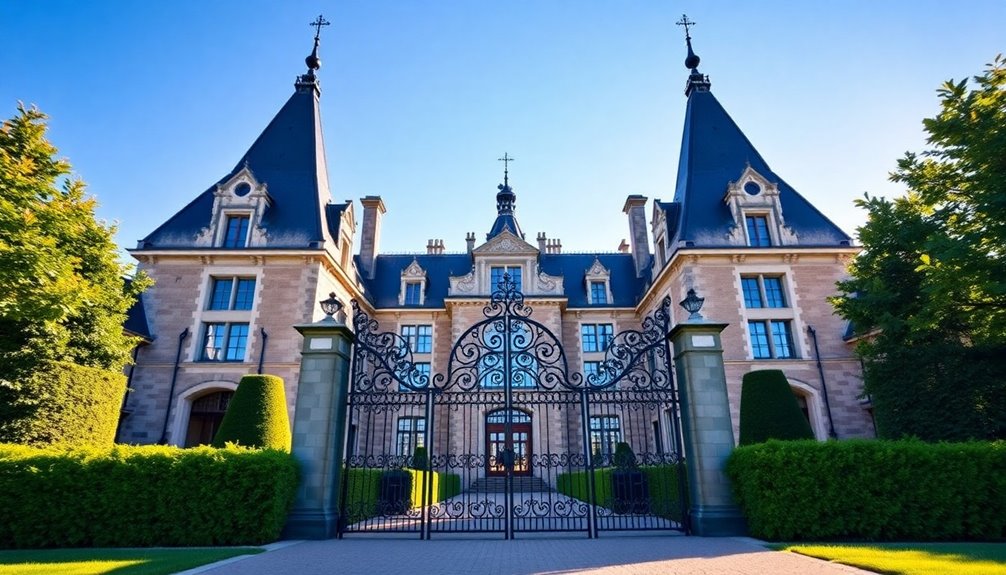
While modern interpretations of châteaux embrace contemporary design, they still honor classic features that define this architectural style. You'll notice steeply pitched roofs and ornate façades that evoke the elegance of historical châteaux.
The Châteauesque style, popular in the U.S. during the late 19th and early 20th centuries, beautifully blends Gothic and Renaissance influences, creating grand residences.
Today's modern châteaux often prioritize luxurious living spaces over traditional fortifications, featuring expansive gardens and outdoor areas perfect for leisure and entertainment.
Sustainability and energy efficiency are also key, as contemporary designs integrate modern amenities while preserving a touch of old-world charm.
This revival of château-style architecture reflects a desire for both functionality and grandeur in today's custom-built homes.
Differences From Other Estates
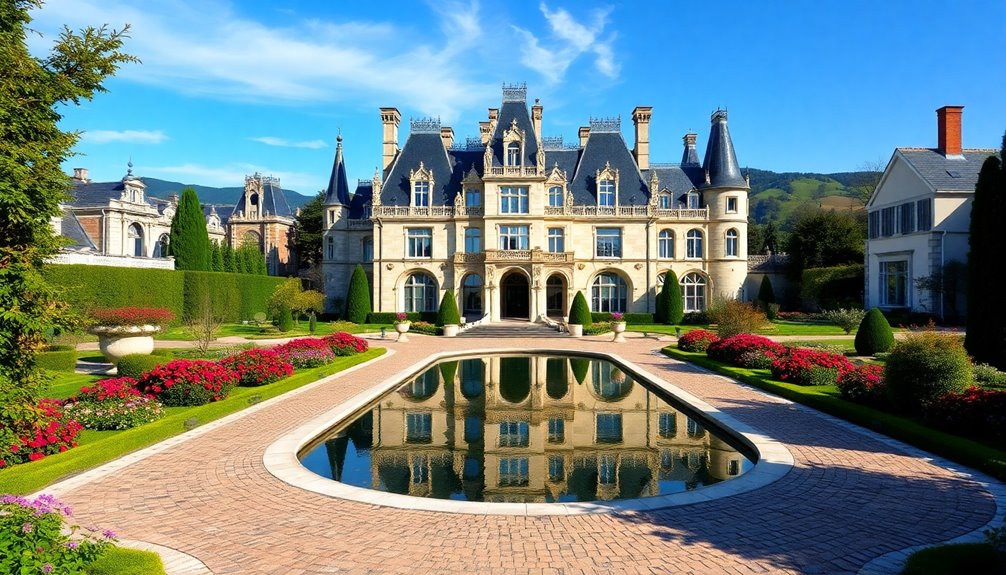
Modern interpretations of châteaux highlight their distinctive qualities, setting them apart from other estates like manors. Unlike manors, which often functioned within the feudal system, châteaux evolved from fortified military strongholds to symbols of elegance.
Here are three key differences:
- Fortifications: Châteaux, like the Château de Chambord, boast thick stone walls and defensive structures, unlike the simpler designs of manors.
- Aesthetic Appeal: Châteaux focus on beauty, often nestled in picturesque landscapes, whereas manors prioritize agricultural functionality.
- Architectural Features: Châteaux display grand, symmetrical designs with ornate facades, contrasting with the more utilitarian forms of manors.
These elements not only enhance their grandeur but also reflect the changing values of society throughout history. Additionally, the construction and design of châteaux often incorporate principles of thermal energy transfer, ensuring comfort and efficiency in their large, elegant spaces.
Frequently Asked Questions
What Classifies a House as a Chateau?
To classify a house as a château, you'll look for specific architectural features.
It typically has thick stone walls and towers that hint at its fortified past. You'll notice elegant Renaissance elements, like large windows and symmetrical layouts.
Ornate facades and lavish interiors reflect the nobility's wealth. Add extensive gardens that enhance the overall beauty, and you'll see how these elements create the enchanting allure of a true château.
What Are the Characteristics of a Chateau?
When you think about the characteristics of a château, you'll notice thick stone walls that hint at their defensive past.
You're likely to see symmetrical layouts with grand columns and large windows that invite natural light.
Ornate facades and lavish interiors showcase wealth, especially during the Baroque and Rococo periods.
You might also observe elements like pointed arches in Gothic Revival styles, blending historical elegance with modern functionality and charm.
What Qualifies as a Chateau?
A château stands like a regal crown atop the landscape, embodying elegance and history.
To qualify as a château, a house often features grand architectural elements, such as towers and thick stone walls, reflecting its fortified origins.
You'll find expansive grounds with formal gardens that enhance its beauty.
Typically associated with nobility, a château serves both as a residence and a symbol of power, showcasing the cultural richness of its era.
What Designates a Chateau?
A château's designation involves a blend of architectural grandeur and historical context.
You'll notice its thick stone walls and large windows, which showcase an elegant aesthetic. Typically, these structures feature symmetrical layouts with formal gardens, emphasizing beauty and balance.
The ornate facades reflect various historical styles, while extensive grounds often include moats and courtyards.
Ultimately, a château represents a shift from fortified living to luxurious, comfortable residences, capturing both history and opulence.
Conclusion
At its core, a château is more than just a grand house; it's a living tapestry of history, art, and culture woven into the fabric of its surroundings. As you wander through its opulent halls and manicured gardens, you can almost hear the whispers of the past echoing through the ages. Whether you're admiring its architectural splendor or its lush landscapes, the essence of a château enchants you, inviting you to become part of its timeless narrative.



